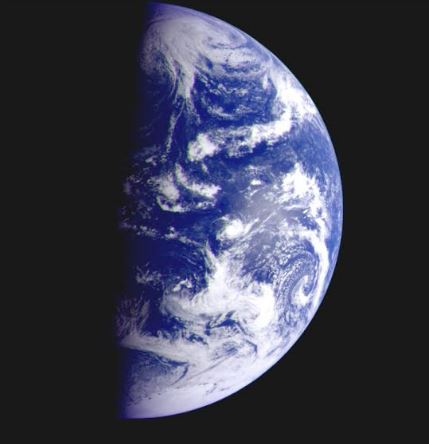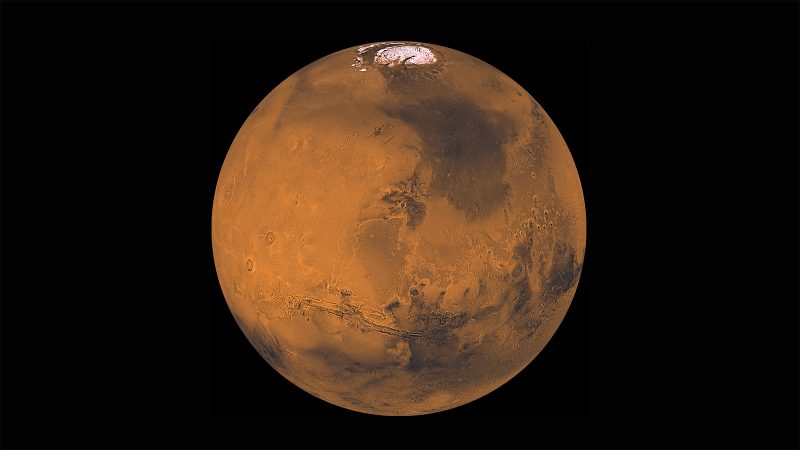1 October 2019
Water distribution affects exoplanets’ habitable zone
Posted by larryohanlon
By Abigail Eisenstadt
Earth-like exoplanets with dry tropical regions can remain habitable at a closer distance to their host star than previously thought, a new study suggests.

Earth is an example of an aqua planet that maintains its water in a habitable zone. This image of Earth taken by the spacecraft Galileo shows its vast Pacific Ocean. Credit: NASA/JPL
Because life on Earth requires liquid water, researchers looking for life beyond Earth’s solar system search for exoplanets that orbit their star within a “habitable zone” where the planet is neither frozen in ice nor completely dry.
Distance to the central star, thickness of the atmosphere, and the amount of water on a planet can affect where its habitable zone lies. The new research in AGU’s Journal of Geophysical Research: Planets, finds where water is distributed on land also impacts how close some types of planets can be to their central star without losing all their water.
The new study finds land planets, which have equal to or less than 10 percent of the volume of Earth’s water, can remain habitable at a closer distance to their host star if most of their water is at the planet’s poles. This means the habitable zone for these types of planets may be different than previously assumed.
“Our results showed the inner edge of the habitable zone is not a single, sharp boundary, but a border whose location changes depending on the planetary surface environment,” said Takanori Kodama, an astrophysicist at the University of Bordeaux in Bordeaux, France, and lead author of the new study.
Water in the habitable zone
The amount of water a planet has limits how close it can be to the heat of its star. Water vapor in the air traps heat like a greenhouse, insulating the planet and making its surface much warmer than it normally would be.
Warmer temperatures and more surface water both cause more water vapor to enter a planet’s atmosphere. If more heat is coming into the atmosphere in the form of solar radiation than the amount of heat that is being expelled as outgoing planetary radiation, the planet gets hotter. This causes more evaporation and more water vapor, subsequently trapping more heat and causing a runaway greenhouse cycle.
On habitable planets, incoming solar radiation and outgoing planetary radiation are balanced.
“Small differences in the amount of water cause significant differences in planets’ climates,” Kodama said.

Mars is an example of a potentially Earth-like planet that lost its liquid water and atmosphere. Credit: NASA/JPL/USGS
Aqua planets, like Earth, have narrow habitable zones because their water-heavy atmospheres limit outgoing planetary radiation while insulating solar radiation, creating a buildup of heat. Land planets have a wider habitable zone, because they have less water in their atmospheres.
Kodama previously established the total amount of water a land planet has can affect how close it can be to its central star before the amount of water vapor thickens the atmosphere and sends the planet into a runaway greenhouse state. After this water vapor threshold is reached, all the planet’s water eventually disappears through evaporation caused by heat accumulation.
The new study examines how water distribution on land planets influences how close they can exist to their host star without entering a runaway greenhouse state. The new results indicate that how close a planet can be to its host star and remain habitable also depends on the planet’s surface water distribution in addition to its overall amount of water. Land planets with drier equators can live closer to their stars.
The researchers used three-dimensional models to simulate the different ways a set volume of water on land planets could be distributed. In one model, the water was distributed closer to the planet’s poles. In the other, water was scattered away from the poles.
They found land planets with more water at their equator have wetter atmospheres, sending them into a greenhouse state. Land planets with water near their poles have drier atmospheres around their tropical regions, because the water vapor does not circulate up to the equator. Those land planets can maintain their water when they are closer to their central stars.
Abigail Eisenstadt is a science writing intern at AGU. Follow her on twitter @aeisenstadt1


 GeoSpace is a blog on Earth and space science, managed by AGU’s Public Information staff. The blog features posts by AGU writers and guest contributors on all sorts of relevant science topics, but with a focus on new research and geo and space sciences-related stories that are currently in the news.
GeoSpace is a blog on Earth and space science, managed by AGU’s Public Information staff. The blog features posts by AGU writers and guest contributors on all sorts of relevant science topics, but with a focus on new research and geo and space sciences-related stories that are currently in the news.